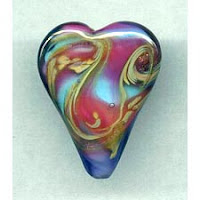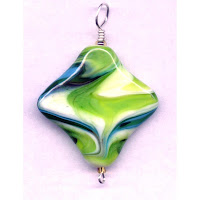 Well, thought I'd use this as a topic in my blog. I've been thinking about how I might refer to my lampwork glass beads, and myself. I'm a lampwork glass beadmaker who has been making beads for about eight years. I have always been very uncomfortable when people classify me as an artist because of what I do. I'm more comfortable being classified as an artisan. Until about two years ago, I certainly didn't feel that what I was doing could be even remotely classified as art. Decent beads, but I still had an awful lot to learn. (And still do.) It seemed like something happened at that time. It wasn't sudden, but I got the distinct impression that I knew what I was doing. It was kind of an amazing feeling. Of course the newness of it has worn off now, but I do feel like my beads show a certain something (most of the time) that wasn't there before. So I have to say that I don't feel that working with glass necessarily makes one an artist, or that all lampworked, blown, or fused glass is art glass. And even now, I don't know whether to classify what I do as art glass. Certainly not all of it is, and what I feel might fit in that category might not meet the expectations of others.
Well, thought I'd use this as a topic in my blog. I've been thinking about how I might refer to my lampwork glass beads, and myself. I'm a lampwork glass beadmaker who has been making beads for about eight years. I have always been very uncomfortable when people classify me as an artist because of what I do. I'm more comfortable being classified as an artisan. Until about two years ago, I certainly didn't feel that what I was doing could be even remotely classified as art. Decent beads, but I still had an awful lot to learn. (And still do.) It seemed like something happened at that time. It wasn't sudden, but I got the distinct impression that I knew what I was doing. It was kind of an amazing feeling. Of course the newness of it has worn off now, but I do feel like my beads show a certain something (most of the time) that wasn't there before. So I have to say that I don't feel that working with glass necessarily makes one an artist, or that all lampworked, blown, or fused glass is art glass. And even now, I don't know whether to classify what I do as art glass. Certainly not all of it is, and what I feel might fit in that category might not meet the expectations of others.I started a forum about this subject at lampwork, etc. and have gotten a lot of different responses. No conclusion, as I'm sure you can guess, but out of it all, I've decided that, for me, artisan is the correct word. And I don't think I am wrong to call it art glass (or perhaps glass art!)Of course, much of this is semantics. The dictionary is fairly loose with its definition of art, and the distinction between an artist and an artisan is a bit blurry. Here's what my Webster's New World Dictionary has to say:
Artisan: A worker in a skilled trade; craftsman
Artist: 1) A person who is works in, or is skilled in the techniques of, any of the fine arts, esp. in painting, drawing, sculpture, etc. 2) a person who does anything very well, with imagination and a feeling for form, effect, etc.
I would quote some of the folks who participated in the forum, but I may misconstrue, so I'll let you go there and decide yourself. I know some of these discussions get a bit heated, but this one has been quite civil, and I have enjoyed reading the varying opinions. You can read it , and add your two cents if you wish! The address is: http://www.lampworketc.com/forums/showthread.php?t=78916


